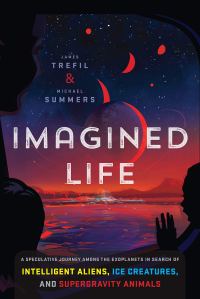Stellar Engineering by Greg Matlof and C Bangs

Stellar Engineering looks at Kepler’s data studying exoplanets and speculation surrounding alien artificial structures, such as Stapledon/Dyson Spheres. The book addresses many aspects of these alien mega-structures: How did the idea develop? Are there terrestrial analogs to constructs that might encompass an entire solar system? What might be the purpose or purposes of such constructs? Have there been astronomical searches for such constructs that predate the Kepler mission? The book is illustrated throughout with supplementary imagery from NASA and other sources, as well as art from C Bangs. (April 2019)
And if you’re interested in the Dyson Sphere, Freeman Dyson’s autobiography published last year, Maker of Patters, just came out in paperback last month.

Imagined Life: A Speculative Scientific Journey among the Exoplanets in Search of Intelligent Aliens, Ice Creatures, and Supergravity Animals by James Trefil and Michael Summers
 Planetary scientist Michael Summers and physics professor James Trefil take what we know about exoplanets and life on our own world and use that data to hypothesize about how, where, and which sorts of life might develop. (September 2019)
Planetary scientist Michael Summers and physics professor James Trefil take what we know about exoplanets and life on our own world and use that data to hypothesize about how, where, and which sorts of life might develop. (September 2019)
Publishers Weekly says, “Posing a far-reaching question—what will alien life look like when humankind finds it?—the coauthors of Exoplanets explore possible answers in this lively, imaginative, and accessible look at cutting-edge exobiology. This is a marvelous introduction to a field fueled by both imagination and science.” (Starred Review)

Extraterrestrial Languages Daniel Oberhaus
Exploring Earthlings’ various attempts to reach out to non-Earthlings over the centuries, journalist Daniel Oberhaus poses some not entirely answerable questions: If we send a message into space, will extraterrestrial beings receive it? Will they understand? What languages will they (and we) speak? Is there not merely a universal grammar (as Noam Chomsky has posited), but a grammar of the universe? Oberhaus considers how philosophy, linguistics, mathematics, science, and art have informed the design or limited the effectiveness of our interstellar messaging. (October 2019)

Light of the Stars: Alien Worlds and the Fate of the Earth by Adam Frank
 In this 2018 publication, astrophysicist and NPR commentator Adam Frank writes on what the latest research on the existence and trajectories of alien civilizations may teach us about our own. Written with great clarity and conviction, Light of the Stars builds on the inspiring work of pioneering scientists such as Frank Drake and Carl Sagan, whose work at the dawn of the space age began building the new science of astrobiology; Jack James, the Texas-born engineer who drove NASA’s first planetary missions to success; Vladimir Vernadsky, the Russian geochemist who first envisioned the Earth’s biosphere; and James Lovelock and Lynn Margulis, who invented Gaia theory. Light of the Stars will be released in paperback this August.
In this 2018 publication, astrophysicist and NPR commentator Adam Frank writes on what the latest research on the existence and trajectories of alien civilizations may teach us about our own. Written with great clarity and conviction, Light of the Stars builds on the inspiring work of pioneering scientists such as Frank Drake and Carl Sagan, whose work at the dawn of the space age began building the new science of astrobiology; Jack James, the Texas-born engineer who drove NASA’s first planetary missions to success; Vladimir Vernadsky, the Russian geochemist who first envisioned the Earth’s biosphere; and James Lovelock and Lynn Margulis, who invented Gaia theory. Light of the Stars will be released in paperback this August.

The Planet Factory: Exoplanets and the Search for a Second Earth by Elizabeth Tasker
 The Planet Factory takes the reader to the cutting edge of the ongoing search for worlds like our own, and the hints of life elsewhere in the cosmos. Astrophysicist Elizabeth Tasker discusses the way these planets form, their structure and features, and describes in detail the detection techniques used (there are many) before looking at what we can learn about the surface environments and planetary atmospheres, and whether this hints at the tantalizing possibility of life. First published in 2017, The Planet Factory just came out in paperback last month.
The Planet Factory takes the reader to the cutting edge of the ongoing search for worlds like our own, and the hints of life elsewhere in the cosmos. Astrophysicist Elizabeth Tasker discusses the way these planets form, their structure and features, and describes in detail the detection techniques used (there are many) before looking at what we can learn about the surface environments and planetary atmospheres, and whether this hints at the tantalizing possibility of life. First published in 2017, The Planet Factory just came out in paperback last month.

0 comments on “Exoplanets, Astrobiology, and Alien Megastructures”